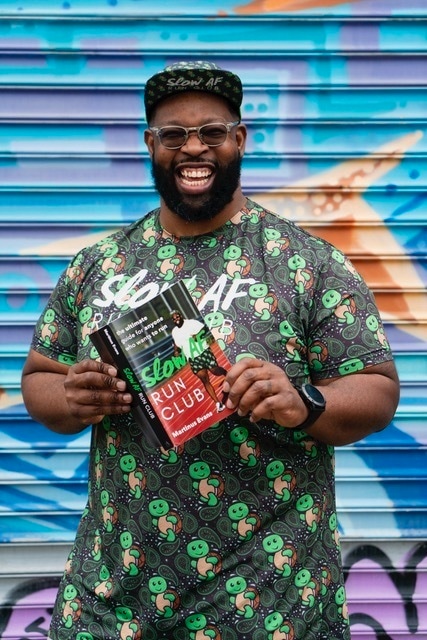Stand on the sidelines of a marathon, and you’ll encounter participants of all walks of life: high schoolers running alongside senior citizens; spandex-clad bodies sharing strides with people in tutus and religious head coverings; athletes pushing strollers, cheering on athletes in wheelchairs; elites battling for podium spots ahead of amateurs conquering their first race.
Many marathon training and racing guides are written for those gunning for competitive times and personal bests (PBs). This is not one of them. This is a manual for anyone who aspires to cross the finish line but either doesn’t want, or, for any number of reasons, is unable to do so in less than five hours. (A five-hour marathon requires an 11:27 mile pace.)
Below, you’ll find training and racing tips from three individuals—runners, coaches or both—with a wealth of five-hour-plus marathon experience: Martinus Evans, a marathoner, coach, author and the founder of the Slow AF Run Club; Latoya Shauntay Snell, a multisport endurance athlete, ultrarunner and advocate for body inclusivity; and Aaliyah Earvin, a certified personal trainer, run coach and the owner of Aaliyah Earvin coaching.
Read on or click on the links below to go directly to the section.
- Before You Start Training: Your preparation will be as important as your buildup. Here’s what to prioritize before you begin a training plan.
- Training for 26.2: Running a marathon in over five hours takes an extra level of grit. Here are some pointers to keep in mind as you log your miles in training.
- Race Day: Strategies, both physical and mental, to embrace on the big day.
Before You Start Training
Understand the nature of your commitment. While you may be able to sign up for a 5K at the last minute, a marathon presents a beast of a distance that demands more serious preparation. “In order to run a marathon, you have to make a commitment and accept that there are some things that you're going to have to sacrifice in order to achieve that goal,” Evans says. Those sacrifices may include forgoing leisurely mornings in bed, skipping late-nights outings with friends, or avoiding mindless hours scrolling social media or watching TV.
Identify your “why.” Before you even start training, pinpoint your reason for running. For Snell, that’s something that is constantly evolving. At first, she was motivated by medals and finish line celebrations. Now, her goal is “to help people see a braver version of themselves.” To identify your personal “why,” think or journal about what attracted you to running in the first place, why you’ve chosen to stick with it, how running makes you feel and what you ultimately want out of the whole marathon training process. Knowing your purpose will bolster you when the going gets tough in both training and the race itself.
Add a buffer to your training timeline. Most marathon training plans last between 12 and 20 weeks, but Snell suggests tacking on a couple more weeks to the plan you’re using, especially if you’re a new marathoner or trying to balance marathon training with a hectic schedule. “If it’s suggested for you to do 16 weeks, give yourself 18 to 20,” she says. The extra time will allow you to miss a day of training here and there, to get unusual aches or pains checked out by a doctor, and to generally take a more flexible approach to the whole endeavor.
Construct a realistic schedule. At the start of a new marathon training block (a designated period of marathon-specific training), Earvin encourages the athletes she coaches to look at their calendars and prioritize runs according to their ambitions and time constraints: “Identify what’s most important in a given week.” If your primary goal isn’t necessarily to get faster, but to go the distance, for example, long runs should take precedence over speedwork. If you know you’ll have a hard time fitting in a five-hour run, consider doing a three-hour run one day and a one- or two-hour run the next. Be realistic and don’t be afraid to get creative.
Training for 26.2
Run for time, not just distance. Many runners are hardwired to think in terms of miles. Snell learned from a past coach that running for time instead of distance—going out for a 30-minute run instead of a two-mile run, for example—can be a refreshing shift. Not only does it allow for more precise planning, but it can also reduce the temptation to run too hard too often or to get overly competitive with yourself. Snell now blends mileage-driven runs with timed runs, which are especially helpful on days when her schedule is tight.
Plan to cross train. One of the best ways to avoid injury and strengthen your whole body while enduring the rigors of marathon training is to cross-train. If you don’t, Evans warns there’s a good chance you’ll wind up in a doctor’s office or physical therapy clinic. For runners, any low-impact exercise that’s not running will do: walking, biking, yoga, swimming, et cetera. You can replace easy runs with cross-training, going by time rather than distance. Evans recommends cross-training at least once a week, and ideally twice.
Don’t forget about strength work. A former sprinter, Earvin is a big believer in strength training. She loves showing her athletes how proper running form, honed through drills (see the dynamic stretches shown here) and strength exercises (especially single-leg ones like lunges) can make the act of running feel smoother and easier. While two to three sessions a week is ideal, she says, “one is better than none.” An easy way to sprinkle strength training in is to add drills to your daily warm-up routine and strength exercises to lighter training days.
Snell, too, is an advocate of strength training—so much so that she often shares short exercise demonstrations on Instagram. While traditional strength work in a gym works for some runners, Snell says bodyweight exercises can be effective too. Her regimen includes two strength sessions a week, lasting 30 to 45 minutes each. If you’re new to strength training, start small (e.g. 10 to 20 minutes once a week) and build up to a duration and frequency that you can stay consistent with.
Prioritize recovery. For Evans, Snell and Earvin alike, recovery is as important a component of marathon training as the running itself. Evans is a fan of ice baths, cryotherapy and massage, although he acknowledges that other runners may have different preferences. Earvin’s recovery tips include eating within 30 to 60 minutes of every run, replenishing your electrolytes, getting eight to 10 hours of sleep and taking naps when possible. And Snell finds that regular mobility work and active recovery days help her bounce back quicker. She encourages those who can to hire a mobility coach, and those who can’t to seek inspiration from YouTube. (Here’s a 13-minute workout led by Morit Summers she recommends.)
Stage a few dress rehearsals. Especially when you’ll be racing for multiple hours, the “nothing new on race day” adage is important to uphold. Training offers the perfect opportunity to trial run everything from your socks and shoes to your fueling and pacing strategies. If something doesn’t feel right, tweak it and try again until you’re confident about as many race day variables as you can control.
For race day essentials, Evans says that spandex is clutch: It helps “keep all your bits and pieces in place,” as he puts it, and also reduces chafing. Earvin highly encourages layering, as a lot can change over the course of a multiple-hour race. And both of them are big on lubricants such as Vaseline and Bodyglide, as chafing can be a real issue during several hours of moving and sweating. Evans recommends bringing extra lubricant since it tends to wear off over time.
Learn the rules of the course. Don’t wait until you’re out on the course to find out there are only bathrooms every five miles, that hydration packs aren’t allowed or the aid stations will close before your arrival. One of the first things Snell does when choosing a race is scour its website for rules and course maps. Even if what you find isn’t ideal, at least you can go into the race prepared, with as few surprises as possible.
Going the Distance on Race Day
Embrace run-walking. There’s a common misconception that walking on a run or in a race is a sign of weakness. The sooner you let go of that fallacy, the better. All three experts strongly defend the run-walk method and implement it in their own ways. Snell, who says, “run-walking has gotten me across almost every finish line,” likes to set her Garmin watch to intervals. She’ll alternate running for 45 seconds or one minute, and walking for 15 seconds during a half or full marathon. Earvin, who has run her best races while walking every time she fuels, says that some of her runners are able to run a 5K at a time, with a single one- to two-minute walk in between, while others work their way up to run intervals that are twice as long as their walking intervals. Whatever you plan to do in your race, practice it during your long runs.
Don’t leave your fueling to chance. As mentioned above, not all fueling stations stay open for multiple hours. As inconvenient as it may be, that means that your safest route to a well-fueled 26.2 is to carry everything you plan to eat and drink with you. Evans suggests bringing a lot more fuel than you’re ultimately going to need: “Think of yourself as an ultramarathoner running a very long marathon.” Personal hydration packs, when allowed, are really useful for long races, as are handheld water bottles. Training runs once again offer a chance to practice not just what and when you’re going to eat and drink, but also how you’re going to carry it all as comfortably as possible.
Find a few mental strategies that work for you. All runners, whether front, middle or back of the pack, should have an arsenal of mental strategies that keep them calm, confident and present. Different tactics work for different people. Earvin emphasizes positive affirmations and mental rehearsals, or visualizations of an upcoming run or race down to the sights, smells and taste of your gels. These rehearsals can mentally prepare you for the race and boost your confidence without the physical strain of running. Evans likes finding strangers on the course to swap life stories with, which can take anywhere from 45 minutes to two hours, as well as tricking himself to just keep going a little farther. He identifies a marker, such as the next fire hydrant he comes across, and commits only to making it there. When he does, he repeats the process with another marker, and does that again and again until he reaches the finish line. In addition to reminders of her current “why,” Snell has found success repeating mantras, such as “I can, I will and I’m doing it.” In some of her longer races (marathons and above), she also writes notes to herself listing all the reasons she’s there, which she can pull out of her pocket and read as frequently as every mile. She says looking at those handwritten reminders gives her the boost she needs to reach another finish line—and in doing so, inspire others to “show up just as they are” and take a shot at it too.




